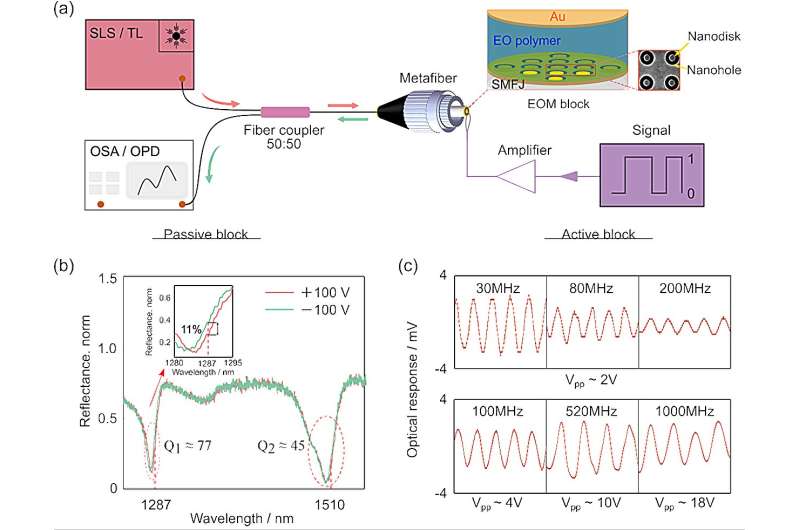This article has been reviewed according to Science X's editorial process and policies. Editors have highlighted the following attributes while ensuring the content's credibility:
fact-checked
peer-reviewed publication
proofread
Team develops way to integrate electro-optic modulator device on end faces of a single-mode optical fiber jumper

Electro-optic modulators (EOMs) are cardinal elements in the optical communication networks that control the amplitude, phase and polarization of a light via external electric signals. Aiming to realize ultracompact and high-performance EOMs, most investigations nowadays target on-chip devices that combine semi-conductor technologies with state-of-art tunable materials. Nevertheless, integrated EOMs, as an independent on-chip element, are commonly separated from light sources.
Thus, extra interfaces that couple the light from light sources to the waveguides of on-chip devices are indispensable. Although state-of-art coupling schemes including edge coupling and grating coupling have been employed, they still suffer from limited integration densities and narrow-band operations, respectively.
Moreover, both coupling schemes require ultra-accurate alignments and complex encapsulations, making on-chip devices expensive for customers. Therefore, an EOM device that circumvents coupling complexity and further reduces coupling losses is needed.
In a new paper published in Light: Science & Applications, a team of scientists has developed methodologies that directly integrate EOM devices on the facet of single-mode optical fiber jumpers, connecting EOM devices with light sources using standard interfaces of optical fibers.
"Embracing the standard nanofabrication methodologies developed in our previous work, the EOM block can be directly integrated on the tips of single-mode optical fibers, so the metafiber EOMs intrinsically avoid the coupling treatment," Prof. Min Qiu said.
Such plasmonic metafiber EOMs feature a well-defined plasmonic-organic hybrid configuration. Profiting from ultrathin and high quality-factor plasmonic metasurfaces, nanofabrication-friendly and highly efficient EO polymers, the spectral amplitude and quality factor of passed light are well controlled to promote resonance sensitivity for EO modulation.
"More interestingly, by rational[ly] designing the plasmonic modes, resonant waveguided modes and Fabry-Perot modes, tunable dual-band operations can be achieved in telecom O band and S band," co-first authors Lei Zhang and Xinyu Sun added.
The metafiber EOMs were further driven by direct/alternating current electrical signals. The modulation speed of metafiber EOM can reach as high as 1000 MHz with a bias voltage of ±9 V, which is the best performance for lumped fiber-integrated EOMs.
"Such metafiber EOMs provide new perspectives on designing [a] ultracompact and high performance EO device for applications where compact configuration, highly integrated capability and low coupling loss are required, such as in active mode-locking fiber lasers and tunable broadband fiber polarizers. This work also offers an avenue to 'plug-and-play' implementations of EO devices and ultracompact 'all-in-fibers' optical systems for communications, imaging, sensing and many others," Prof. Jiyong Wang added.
More information: Lei Zhang et al, Plasmonic metafibers electro-optic modulators, Light: Science & Applications (2023). DOI: 10.1038/s41377-023-01255-7
Journal information: Light: Science & Applications
Provided by Light Publishing Center, Changchun Institute of Optics, Fine Mechanics And Physics, CAS




















